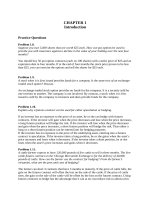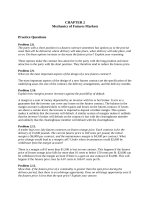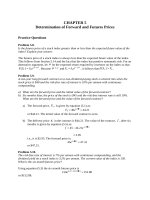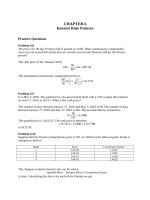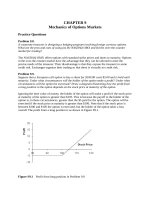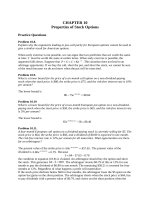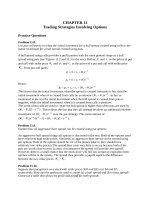Solutions fundamentals of futures and options markets 7e by hull chapter 13
Bạn đang xem bản rút gọn của tài liệu. Xem và tải ngay bản đầy đủ của tài liệu tại đây (137.37 KB, 12 trang )
CHAPTER 13
Valuing Stock Options: The Black-Scholes-Merton Model
Practice Questions
Problem 13.8.
A stock price is currently $40. Assume that the expected return from the stock is 15% and its
volatility is 25%. What is the probability distribution for the rate of return (with continuous
compounding) earned over a one-year period?
In this case 015 and 025 . From equation (13.4) the probability distribution for the
rate of return over a one-year period with continuous compounding is:
�
�
0252
�015
025 �
2
�
�
i.e.,
(011875 025)
The expected value of the return is 11.875% per annum and the standard deviation is 25.0%
per annum.
Problem 13.9.
A stock price has an expected return of 16% and a volatility of 35%. The current price is $38.
a) What is the probability that a European call option on the stock with an exercise price
of $40 and a maturity date in six months will be exercised?
b) What is the probability that a European put option on the stock with the same exercise
price and maturity will be exercised?
a) The required probability is the probability of the stock price being above $40 in six
months time. Suppose that the stock price in six months is ST
0352
ln ST : (ln 38 (016
)05 035 05)
2
i.e.,
ln ST : (3687 0247)
Since ln 40 3689 , the required probability is
�3689 3687 �
1 N �
� 1 N (0008)
� 0247
�
From normal distribution tables N(0.008) = 0.5032 so that the required probability is
0.4968.
b) In this case the required probability is the probability of the stock price being less than
$40 in six months time. It is
1 04968 05032
Problem 13.10.
Prove that, with the notation in the chapter, a 95% confidence interval for ST is between
S0 e(
2
2)T 196 T
and
S0 e(
2
2) T 196 T
From equation (13.2):
ln ST : [ln S0 (
2
)T T ]
2
95% confidence intervals for ln ST are therefore
ln S0 (
2
)T 196 T
2
and
2
ln S0 ( )T 196 T
2
95% confidence intervals for ST are therefore
eln S0 (
2
2)T 196 T
and
eln S0 (
S0 e(
2
2)T 196 T
and
S0 e(
2
2)T 196 T
i.e.
2
2) T 196 T
Problem 13.11.
A portfolio manager announces that the average of the returns realized in each of the last 10
years is 20% per annum. In what respect is this statement misleading?
This problem relates to the material in Section 13.2. The statement is misleading in that a
certain sum of money, say $1000, when invested for 10 years in the fund would have realized
a return (with annual compounding) of less than 20% per annum.
The average of the returns realized in each year is always greater than the return per annum
(with annual compounding) realized over 10 years. The first is an arithmetic average of the
returns in each year; the second is a geometric average of these returns.
Problem 13.12.
Assume that a non-dividend-paying stock has an expected return of and a volatility of .
An innovative financial institution has just announced that it will trade a derivative that pays
off a dollar amount equal to
1 �ST �
ln � �
T �S0 �
at time T . The variables S 0 and ST denote the values of the stock price at time zero and
time T .
a) Describe the payoff from this derivative.
b) Use risk-neutral valuation to calculate the price of the derivative at time zero.
a) The derivative will pay off a dollar amount equal to the continuously compounded
return on the security between times 0 and T .
b) The expected value of ln( ST S0 ) is, from equation (13.4), ( 2 2)T . The
expected payoff from the derivative is therefore 2 2 . In a risk-neutral world
this becomes r 2 2 . The value of the derivative at time zero is therefore:
� 2 � rT
e
�r
�
� 2 �
Problem 13.13.
What is the price of a European call option on a non-dividend-paying stock when the stock
price is $52, the strike price is $50, the risk-free interest rate is 12% per annum, the volatility
is 30% per annum, and the time to maturity is three months?
In this case S0 52 , K 50 , r 012 , 030 and T 025 .
d1
ln(52 50) (012 032 2)025
05365
030 025
d 2 d1 030 025 03865
The price of the European call is
52 N (05365) 50e012�025 N (03865)
52 �07042 50e 003 �06504
506
or $5.06.
Problem 13.14.
What is the price of a European put option on a non-dividend-paying stock when the stock
price is $69, the strike price is $70, the risk-free interest rate is 5% per annum, the volatility
is 35% per annum, and the time to maturity is six months?
In this case S0 69 , K 70 , r 005 , 035 and T 05 .
d1
ln(69 70) (005 035 2 2) �05
01666
035 05
d 2 d1 035 05 00809
The price of the European put is
70e 005�05 N (00809) 69 N (01666)
70e0025 �05323 69 �04338
640
or $6.40.
Problem 13.15.
A call option on a non-dividend-paying stock has a market price of $250 . The stock price is
$15, the exercise price is $13, the time to maturity is three months, and the risk-free interest
rate is 5% per annum. What is the implied volatility?
In the case c 25 , S0 15 , K 13 , T 025 , r 005 . The implied volatility must be
calculated using an iterative procedure.
A volatility of 0.2 (or 20% per annum) gives c 220 . A volatility of 0.3 gives c 232 . A
volatility of 0.4 gives c 2507 . A volatility of 0.39 gives c 2487 . By interpolation the
implied volatility is about 0.396 or 39.6% per annum.
The implied volatility can also be calculated using DerivaGem. Select equity as the
Underlying Type in the first worksheet. Select Analytic European as the Option Type. Input
stock price as 15, the risk-free rate as 5%, time to exercise as 0.25, and exercise price as 13.
Leave the dividend table blank because we are assuming no dividends. Select the button
corresponding to call. Select the implied volatility button. Input the Price as 2.5 in the second
half of the option data table. Hit the Enter key and click on calculate. DerivaGem will show
the volatility of the option as 39.64%.
Problem 13.16.
Show that the Black–Scholes–Merton formula for a call option gives a price that tends to
max ( S0 K 0) as T � 0 .
ln( S0 K ) (r 2 2)T
d1
T
ln( S0 K ) r 2 2
T
T
As T � 0 , the second term on the right hand side tends to zero. The first term tends to � if
ln( S0 K ) 0 and to � if ln( S0 K ) 0 . Since ln( S0 K ) 0 when S0 K and
ln( S0 K ) 0 when S0 K , it follows that
d 1 as T 0 when S 0 K
d1 as T 0 when S 0 K
Similarly
d 2 as T 0 when S 0 K
d 2 as T 0 when S 0 K
Under the Black-Scholes-Merton formula the call price, c is given by:
c S0 N (d1 ) Ke rT N (d 2 )
From the above results, when S0 K , N (d1 ) � 10 and N (d 2 ) � 10 as T � 0 so that
c � S 0 K . Also, when S0 K , N (d1 ) � 0 and N (d 2 ) � 0 as T � 0 so that c � 0 .
These results show that c � max( S0 K 0) as T � 0 .
Problem 13.17.
Explain carefully why Black’s approach to evaluating an American call option on a dividendpaying stock may give an approximate answer even when only one dividend is anticipated.
Does the answer given by Black’s approach understate or overstate the true option value?
Explain your answer.
Black’s approach in effect assumes that the holder of option must decide at time zero whether
it is a European option maturing at time tn (the final ex-dividend date) or a European option
maturing at time T . In fact the holder of the option has more flexibility than this. The holder
can choose to exercise at time tn if the stock price at that time is above some level but not
otherwise. Furthermore, if the option is not exercised at time tn , it can still be exercised at
time T .
It appears that Black’s approach should understate the true option value. This is because the
holder of the option has more alternative strategies for deciding when to exercise the option
than the two strategies implicitly assumed by the approach. These alternative strategies add
value to the option.
However, this is not the whole story! The standard approach to valuing either an American or
a European option on a stock paying a single dividend applies the volatility to the stock price
less the present value of the dividend. (The procedure for valuing an American option is
explained in Chapter 18.) Black’s approach when considering exercise just prior to the
dividend date applies the volatility to the stock price itself. Black’s approach therefore
assumes more stock price variability than the standard approach in some of its calculations.
In some circumstances it can give a higher price than the standard approach.
Problem 13.18.
Consider an American call option on a stock. The stock price is $70, the time to maturity is
eight months, the risk-free rate of interest is 10% per annum, the exercise price is $65, and
the volatility is 32%. A dividend of $1 is expected after three months and again after six
months. Use the results in the appendix to show that it can never be optimal to exercise the
option on either of the two dividend dates. Use DerivaGem to calculate the price of the
option.
With the notation in the text
D1 D2 1 t1 025 t2 050 T 06667 r 01 and
K 65
K (1 e r (T t2 ) ) 65(1 e 01�01667 ) 107
Hence
D2 K (1 e r (T t2 ) )
Also:
K (1 e r (t2 t1 ) ) 65(1 e 01�025 ) 160
Hence:
D1 K (1 e r ( t2 t1 ) )
It follows from the conditions established in the Appendix to Chapter 13 that the option
should never be exercised early. The option can therefore be value as a European option.
The present value of the dividends is
e 025�01 e050�01 19265
Also:
S0 680735 K 65 032 r 01 T 06667
ln(680735 65) (01 032 2 2)06667
d1
05626
032 06667
d 2 d1 032 06667 03013
N (d1 ) 07131 N (d 2 ) 06184
and the call price is
680735 �07131 65e 01�06667 �06184 1094
or $10.94.
DerivaGem can be used to calculate the price of this option. Select equity as the Underlying
Type in the first worksheet. Select Analytic European as the Option Type. Input stock price as
70, the volatility as 32%, the risk-free rate as 10%, time to exercise as =8/12, and exercise
price as 65. In the dividend table, enter the times of dividends as 0.25 and 0.50, and the
amounts of the dividends in each case as 1. Select the button corresponding to call. Hit the
Enter key and click on calculate. DerivaGem will show the value of the option as $10.942.
Problem 13.19.
A stock price is currently $50 and the risk-free interest rate is 5%. Use the DerivaGem
software to translate the following table of European call options on the stock into a table of
implied volatilities, assuming no dividends. Are the option prices consistent with the
assumptions underlying Black–Scholes–Merton?
Stock Price
54
50
55
Maturity = 3 months
7.00
3.50
1.60
Maturity = 6 months
8.30
5.20
2.90
Maturity = 12 months
10.50
7.50
5.10
Using DerivaGem we obtain the following table of implied volatilities
Stock Price
54
50
55
Maturity = 3 months
37.78
34.15
31.98
Maturity = 6 months
34.99
32.78
30.77
Maturity = 12 months
34.02
32.03
30.45
To calculate first number, select equity as the Underlying Type in the first worksheet. Select
Analytic European as the Option Type. Input stock price as 50, the risk-free rate as 5%, time
to exercise as 0.25, and exercise price as 45. Leave the dividend table blank because we are
assuming no dividends. Select the button corresponding to call. Select the implied volatility
button. Input the Price as 7.0 in the second half of the option data table. Hit the Enter key and
click on calculate. DerivaGem will show the volatility of the option as 37.78%. Change the
strike price and time to exercise and recompute to calculate the rest of the numbers in the
table.
The option prices are not exactly consistent with Black–Scholes–Merton. If they were, the
implied volatilities would be all the same. We usually find in practice that low strike price
options on a stock have significantly higher implied volatilities than high strike price options
on the same stock. This phenomenon is discussed in Chapter 19.
Problem 13.20.
Show that the Black–Scholes–Merton formulas for call and put options satisfy put–call
parity.
The Black–Scholes–Merton formula for a European call option is
c S0 N (d1 ) Ke rT N (d 2 )
so that
c Ke rT S0 N (d1 ) Ke rT N (d 2 ) Ke rT
or
c Ke rT S0 N (d1 ) Ke rT [1 N (d 2 )]
or
c Ke rT S 0 N (d1 ) Ke rT N (d 2 )
The Black–Scholes–Merton formula for a European put option is
p Ke rT N (d 2 ) S0 N (d1 )
so that
p S0 Ke rT N (d 2 ) S 0 N (d1 ) S 0
or
p S0 Ke rT N ( d 2 ) S 0 [1 N (d1 )]
or
p S0 Ke rT N ( d 2 ) S0 N (d1 )
This shows that the put–call parity result
c Ke rT p S 0
holds.
Problem 13.21.
Show that the probability that a European call option will be exercised in a risk-neutral
world is, with the notation introduced in this chapter, N ( d 2 ) . What is an expression for the
value of a derivative that pays off $100 if the price of a stock at time T is greater than K ?
The probability that the call option will be exercised is the probability that ST K where ST
is the stock price at time T . In a risk neutral world
ln ST : [ln S0 ( r 2 2)T T ]
The probability that ST K is the same as the probability that ln ST ln K . This is
�
ln K ln S0 (r 2 2)T �
1 N �
�
T
�
�
�
ln( S K ) (r 2 2)T �
N� 0
�
T
�
�
N (d 2 )
The expected value at time T in a risk neutral world of a derivative security which pays off
$100 when ST K is therefore
100 N (d 2 )
From risk neutral valuation the value of the security at time t is
100e rT N (d 2 )
Further Questions
Problem 13.22.
A stock price is currently $50. Assume that the expected return from the stock is 18% per
annum and its volatility is 30% per annum. What is the probability distribution for the stock
price in two years? Calculate the mean and standard deviation of the distribution. Determine
the 95% confidence interval.
In this case S0 50 , 018 and 030 . The probability distribution of the stock price in
two years, ST , is lognormal and is, from equation (13.2), given by:
0.09
ln S T ~ ln 50 0.18
2, 0.3 2
2
i.e.,
ln S T ~ ( 4.18, 0.42)
The mean stock price is from equation (13.3)
50e 018�2 50e 036 7167
and the standard deviation is
50e018�2 e 009�2 1 3183
95% confidence intervals for ln ST are
418 196 �042 and 418 196 �042
i.e.,
335 and 501
These correspond to 95% confidence limits for ST of
e335 and e501
i.e.,
2852 and 15044
Problem 13.23. (Excel file)
Suppose that observations on a stock price (in dollars) at the end of each of 15 consecutive
weeks are as follows:
30.2, 32.0, 31.1, 30.1, 30.2, 30.3, 30.6, 33.0,
32.9, 33.0, 33.5, 33.5, 33.7, 33.5, 33.2
Estimate the stock price volatility. What is the standard error of your estimate?
The calculations are shown in the table below
�u
009471 �ui2 001145
and an estimate of standard deviation of weekly returns is:
i
001145 0094712
002884
13
14 �13
The volatility per annum is therefore 002884 52 02079 or 20.79%. The standard error of
this estimate is
02079
00393
2 �14
or 3.9% per annum.
Week
Closing Stock Price
($)
Price Relative
Si Si 1
Daily Return
ui ln( Si Si 1 )
1
2
3
4
5
6
7
8
9
10
11
12
13
14
15
30.2
32.0
31.1
30.1
30.2
30.3
30.6
33.0
32.9
33.0
33.5
33.5
33.7
33.5
33.2
1.05960
0.97188
0.96785
1.00332
1.00331
1.00990
1.07843
0.99697
1.00304
1.01515
1.00000
1.00597
0.99407
0.99104
0.05789
–0.02853
–0.03268
0.00332
0.00331
0.00985
0.07551
–0.00303
0.00303
0.01504
0.00000
0.00595
–0.00595
–0.00900
Problem 13.24.
2
A financial institution plans to offer a derivative that pays off a dollar amount equal to ST at
time T where ST is the stock price at time T . Assume no dividends. Defining other variables
as necessary use risk-neutral valuation to calculate the price of the derivative at time zero.
2
(Hint: The expected value of ST can be calculated from the mean and variance of ST given
in Section 13.1.)
From Section 13.1, if E denotes expected value,
E ( ST ) S 0 e T
var( ST ) S02e2 T (e T 1)
2
2
2
2
2
Because var( ST ) E[( ST ) ] [ E ( ST )] , it follows that E[( ST ) ] var( ST ) [ E ( ST )] so that
2
E[( ST ) 2 ] S02 e2 T (e T 1) S02 e 2 T
In a risk-neutral world r so that
S02e2
2
)T
2
E[( ST ) 2 ] S02e (2 r )T
Using risk-neutral valuation, the value of the derivative security at time zero is
e rT E[( ST ) 2 ]
S02 e(2 r
2
)T
e rT
S02 e( r
2
)T
Problem 13.25.
Consider an option on a non-dividend-paying stock when the stock price is $30, the exercise
price is $29, the risk-free interest rate is 5% per annum, the volatility is 25% per annum, and
the time to maturity is four months.
a. What is the price of the option if it is a European call?
b. What is the price of the option if it is an American call?
c. What is the price of the option if it is a European put?
d. Verify that put–call parity holds.
In this case S0 30 , K 29 , r 005 , 025 and T 4 12
d1
ln(30 29) (005 0252 2) �4 12
04225
025 03333
d2
ln(30 29) (005 0252 2) �4 12
02782
025 03333
N (04225) 06637
N (02782) 06096
N (04225) 03363
N (02782) 03904
a. The European call price is
30 �06637 29e 005�4 12 �06096 252
or $2.52.
b. The American call price is the same as the European call price. It is $2.52.
c. The European put price is
29e 005�4 12 �03904 30 �03363 105
or $1.05.
d. Put-call parity states that:
p S c Ke rT
In this case c 252 , S0 30 , K 29 , p 105 and e rT 09835 and it is easy to verify
that the relationship is satisfied,
Problem 13.26.
Assume that the stock in Problem 13.25 is due to go ex-dividend in 1.5 months. The expected
dividend is 50 cents.
a. What is the price of the option if it is a European call?
b. What is the price of the option if it is a European put?
c. Use the results in the Appendix to this chapter to determine whether there are any
circumstances under which the option is exercised early.
a. The present value of the dividend must be subtracted from the stock price. This gives
a new stock price of:
30 05e 0125�005 295031
and
d1
ln(295031 29) (005 0252 2) �03333
03068
025 03333
d2
ln(295031 29) (005 0252 2) �03333
01625
025 03333
N (d1 ) 06205 N (d 2 ) 05645
The price of the option is therefore
295031�06205 29e005�4 12 �05645 221
or $2.21.
b. Because
N (d1 ) 03795 N ( d 2 ) 04355
the value of the option when it is a European put is
29e 005�4 12 �04355 295031�03795 122
or $1.22.
c. If t1 denotes the time when the dividend is paid:
K (1 e r (T t1 ) ) 29(1 e 005�02083 ) 03005
This is less than the dividend. Hence the option should be exercised immediately
before the ex-dividend date for a sufficiently high value of the stock price.
Problem 13.27.
Consider an American call option when the stock price is $18, the exercise price is $20, the
time to maturity is six months, the volatility is 30% per annum, and the risk-free interest rate
is 10% per annum. Two equal dividends of 40 cents are expected during the life of the option,
with ex-dividend dates at the end of two months and five months. Use Black’s approximation
and the DerivaGem software to value the option. Suppose now that the dividend is D on
each ex-dividend date. Use the results in the Appendix to determine how high D can be
without the American option being exercised early.
We first value the option assuming that it is not exercised early, we set the time to maturity
equal to 0.5. There is a dividend of 0.4 in 2 months and 5 months. Other parameters are
S0 18 , K 20 , r 10% , 30% . DerivaGem gives the price as 0.7947. We next value
the option assuming that it is exercised at the five-month point just before the final dividend.
DerivaGem gives the price as 0.7668. The price given by Black’s approximation is therefore
0.7947. (DerivaGem also shows that the American option price calculated using the binomial
model with 100 time steps is 0.8243.)
It is never optimal to exercise the option immediately before the first ex-dividend date when
D1 �K [1 e r (t2 t1 ) ]
where D1 is the size of the first dividend, and t1 and t2 are the times of the first and second
dividend respectively. Hence we must have:
D1 �20[1 e (01�025) ]
that is,
D1 �0494
It is never optimal to exercise the option immediately before the second ex-dividend date
when:
D2 �K (1 e r (T t2 ) )
where D2 is the size of the second dividend. Hence we must have:
D2 �20(1 e 01�00833 )
that is,
D2 �0166
It follows that the dividend can be as high as 16.6 cents per share without the American
option being worth more than the corresponding European option.
